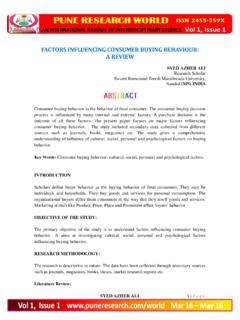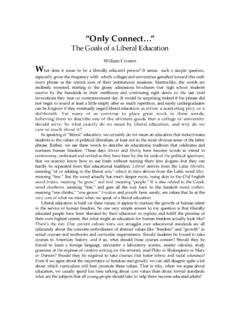Transcription of STYLE AND STYLISTICS: AN OVERVIEW - PUNE RESEARCH
1 PRASANNATA RAMTIRTHE 1P a g e STYLE AND STYLISTICS: AN OVERVIEW PRASANNATA RAMTIRTHE RESEARCH Scholar Savitribai Phule Pune University Pune. (MS) INDIA Stylistics is a systematic way of exploring a literary text especially the language of a text and tries to explain how language creates meaning, STYLE and certain effect. The study of stylistics is considered as one of the significant tools to analyze a literary piece from the point of view of language. There are a number of scholars who are engaged in the interpretation of different genres of literature such as prose, poetry, drama, short story and one-act-play with the help of Stylistics. The interpretation of poetry is possible with the help of some of the important terms in stylistics. The students of literature are to be made aware of the fact that without looking at the individual and collective usages of the lexical items, it is not possible to comprehend the meaning of a poem of any sort.
2 The present article is exclusively devoted to the rudimentary study of Stylistics, an important branch of linguistics. In the beginning, it offers a historical background of Stylistics as a linguistic discipline examines strength and weakness and unfolds its scope and limitations following important definitions. Key words: STYLE , Stylistics, Linguistics, Deviation, Diachronic view, Foregrounding, Figurative use of Lnaguage. Stylistics: A Diachronic View Historically speaking, the study of STYLE can be traced back to the literary scholarships of the Greeks and Romans in the fifth century BC. In this period the rhetoric was the dominant art. This discipline was a set of rules and strategies which enable writers and orators to speak well . In other words, they fully decorated the language with all the figures and tropes to bring about changes in the feelings and opinions of the audience.
3 Stylistics as a sub-discipline came in the limelight in the second half of the twentieth century with the publication of a number of books that included many articles on Stylistics. One of the articles was written by Roman Jacobson in Sebeok s book entitled as Closing Statement: Linguistics and Poetics . Jacobson is an important figure in the historical development of Stylistics as a promising branch of linguistics. PRASANNATA RAMTIRTHE 2P a g e Another important point in the historical development of Stylistics is that it was an extension of literary criticism in the early twentieth century. The main focus of stylistics was on the literary texts rather than the author. In the nineteenth century, the focus was on the author. In Great Britain two important critics such as I.
4 A. Richards and William Empson came on the scene and changed the direction of literary criticism. They more concentrated on the literary texts. They formed the opinion that readers get affected by the text. This approach is known as practical criticism. It is matched by a similar critical movement in the USA, associated with Cleanth Brooks, Ren Wellek, Austin Warren and others, called New Criticism. These two movements proved crucial in the historical development of Stylistics because they laid more emphasis on the literary texts especially on the language of the texts. These critics did not analyse the language of texts very much, but, rather, paid very close attention to the language of the texts. A different, although conceptually similar, tradition of linguistic stylistics was established by British linguists in the 1930s and came to be called British Contextualism.
5 The most important proponents of British Contextualism include John Rupert Firth, Halliday, and John Sinclair. Another development in Stylistics is attributed to the scholars from Eastern Europe and Russia which is known as Russian Formalism. This group consisted of linguists, literary critics and psychologists. They were instrumental in introducing the textual study in the texts which is known as foregrounding theory. This view suggested that some parts of texts had more effect on readers than others in terms of interpretation. The textual parts were linguistically deviant or specially patterned in some way, thus making them psychologically salient (or 'foregrounded') for readers. The Russian Formalists were, in effect, the first stylisticians. But their work was not understood in the west because of the effects of the Russian Revolution in 1917.
6 After the revolution, formalism fell out of favour and, in any case, academic communication between what became the Soviet Union and Western Europe and North America virtually ceased. Roman Jakobson became one of the most influential linguists of the twentieth century, and the reason for his considerable influence on Stylistics, in addition to his own academic brilliance, was because he linked various schools of Linguistics together. He left Moscow at the time of the Russian Revolution and moved to Prague, where he became a member of the Prague Structuralist circle, who were also very interested in the linguistic structure of texts and how they affected readers. What is Stylistics? At the outset, it must be made clear that there are a number of definitions of stylistics given by many scholars in the field of linguistics.
7 However, the following definitions are vital as PRASANNATA RAMTIRTHE 3P a g e they provide us sufficient knowledge to understand the meaning of the term stylistics: Important Definitions: 1. The general definition of stylistics is that it is the study of STYLE of the writers or the literary artists, 2. According to Lucas (1995) stylistics is the effective use of language in prose to make statements or arouse emotions. 3. Stylistics can be also defined as the study of different styles that are present in the text or the utterance of the character. 4. According to David Crystal stylistics is the study of certain aspects of language variations as a part of linguistics. 5. G. N. Leech one of the renowned linguist opines that stylistics is the linguistic approach to literature explaining the relation between language and its artistic function, 6.
8 H. G. Widdowson says that stylistics involves both literary criticism and linguistics. 7. According to K. T. Khader stylistics an intensive study of literary text on an advanced level. 8. In the opinion of Thomas Kane stylistics is the study of linguistic choices the writer makes to express his/her thought and feeling in an effective way. 9. Stylistics can be also defined as the study of the language deviations or the choice of language outside of the range of normal language. 10. Stylistics may be defined as the study of language use according to the situation or the circumstances. The above definitions are helpful in understanding the nature of stylistics. The Nature and Scope of Stylistics As we know that very individual is known from his or her STYLE . Every person in the world possesses some kind of STYLE suitable for him/her.
9 Similarly, every writer has his or her own STYLE of writing. It is observed that every writer makes use of linguistic choices to describe the situation and to portray his characters. Therefore, it is interesting to study how the writers make use of certain structures in their writings. Stylistics deals with a wide range of language varieties and styles that are possible in creating different texts. There are certain possibilities for the writer to make the selection of the words from a wide range of storehouse of the words such as synonyms, antonyms, homonyms, metonymy etc. The writer also makes use of phonological, morphological and syntactic systems of linguistics depending on the situations. Stylistics is the distinctive way to use language. Any prose writer or a poet or a playwright uses his unique method to create a text.
10 The choice of the linguistic units made by the writer reflects his/her ego and the socio-cultural aspects in which the characters and situations exist. PRASANNATA RAMTIRTHE 4P a g e Paul Simpson (2004) says: Why should we do stylistics? To do stylistics is to explore language, and, more specifically, to explore creativity in language use. Doing stylistics thereby enriches our ways of thinking about language and, as observed; exploring language offers a substantial purchase on our understanding of (literary) texts. ( ) Since stylistics is the borderline discipline between language and literature, it focuses on language use in both literary and non-literary texts. It takes into account many disciplines such as literature, sociology, psychology, philosophy and so on.






